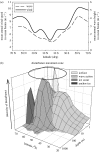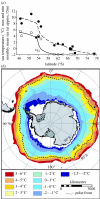Disturbance, colonization and development of Antarctic benthic communities
- PMID: 17405206
- PMCID: PMC3227166
- DOI: 10.1098/rstb.2006.1951
Disturbance, colonization and development of Antarctic benthic communities
Abstract
A decade has yielded much progress in understanding polar disturbance and community recovery-mainly through quantifying ice scour rates, other disturbance levels, larval abundance and diversity, colonization rates and response of benthos to predicted climate change. The continental shelf around Antarctica is clearly subject to massive disturbance, but remarkably across so many scales. In summer, millions of icebergs from sizes smaller than cars to larger than countries ground out and gouge the sea floor and crush the benthic communities there, while the highest wind speeds create the highest waves to pound the coast. In winter, the calm associated with the sea surface freezing creates the clearest marine water in the world. But in winter, an ice foot encases coastal life and anchor ice rips benthos from the sea floor. Over tens and hundreds of thousands of years, glaciations have done the same on continental scales-ice sheets have bulldozed the seabed and the zoobenthos to edge of shelves. We detail and rank modern disturbance levels (from most to least): ice; asteroid impacts; sediment instability; wind/wave action; pollution; UV irradiation; volcanism; trawling; non-indigenous species; freshwater inundation; and temperature stress. Benthic organisms have had to recolonize local scourings and continental shelves repeatedly, yet a decade of studies have demonstrated that they have (compared with lower latitudes) slow tempos of reproduction, colonization and growth. Despite massive disturbance levels and slow recolonization potential, the Antarctic shelf has a much richer fauna than would be expected for its area. Now, West Antarctica is among the fastest warming regions and its organisms face new rapid changes. In the next century, temperature stress and non-indigenous species will drastically rise to become dominant disturbances to the Antarctic life. Here, we describe the potential for benthic organisms to respond to disturbance, focusing particularly on what we know now that we did not a decade ago.
Figures











Similar articles
-
Marine pelagic ecosystems: the west Antarctic Peninsula.Philos Trans R Soc Lond B Biol Sci. 2007 Jan 29;362(1477):67-94. doi: 10.1098/rstb.2006.1955. Philos Trans R Soc Lond B Biol Sci. 2007. PMID: 17405208 Free PMC article. Review.
-
Iceberg killing fields limit huge potential for benthic blue carbon in Antarctic shallows.Glob Chang Biol. 2017 Jul;23(7):2649-2659. doi: 10.1111/gcb.13523. Epub 2016 Oct 26. Glob Chang Biol. 2017. PMID: 27782359
-
Polar zoobenthos blue carbon storage increases with sea ice losses, because across-shelf growth gains from longer algal blooms outweigh ice scour mortality in the shallows.Glob Chang Biol. 2017 Dec;23(12):5083-5091. doi: 10.1111/gcb.13772. Epub 2017 Jun 23. Glob Chang Biol. 2017. PMID: 28643454
-
Polar oceans in a changing climate.Curr Biol. 2017 Jun 5;27(11):R454-R460. doi: 10.1016/j.cub.2017.01.045. Curr Biol. 2017. PMID: 28586678
-
Climate change and the marine ecosystem of the western Antarctic Peninsula.Philos Trans R Soc Lond B Biol Sci. 2007 Jan 29;362(1477):149-66. doi: 10.1098/rstb.2006.1958. Philos Trans R Soc Lond B Biol Sci. 2007. PMID: 17405211 Free PMC article. Review.
Cited by
-
beta-diversity and species accumulation in antarctic coastal benthos: influence of habitat, distance and productivity on ecological connectivity.PLoS One. 2010 Jul 30;5(7):e11899. doi: 10.1371/journal.pone.0011899. PLoS One. 2010. PMID: 20689578 Free PMC article.
-
Antarctic ecology from genes to ecosystems: the impact of climate change and the importance of scale.Philos Trans R Soc Lond B Biol Sci. 2007 Jan 29;362(1477):5-9. doi: 10.1098/rstb.2006.1943. Philos Trans R Soc Lond B Biol Sci. 2007. PMID: 17405205 Free PMC article.
-
Kelp forest community structure and demography in Kongsfjorden (Svalbard) across 25 years of Arctic warming.Ecol Evol. 2024 Jun 25;14(6):e11606. doi: 10.1002/ece3.11606. eCollection 2024 Jun. Ecol Evol. 2024. PMID: 38919650 Free PMC article.
-
An approach using ddRADseq and machine learning for understanding speciation in Antarctic Antarctophilinidae gastropods.Sci Rep. 2021 Apr 19;11(1):8473. doi: 10.1038/s41598-021-87244-5. Sci Rep. 2021. PMID: 33875688 Free PMC article.
-
Increased sea ice cover alters food web structure in East Antarctica.Sci Rep. 2019 May 30;9(1):8062. doi: 10.1038/s41598-019-44605-5. Sci Rep. 2019. PMID: 31147605 Free PMC article.
References
-
- Absher T.M. Larvae. In: Riffenburg B, editor. An encyclopedia of the Antarctic. Routledge; London, UK: 2006. pp. 587–588.
-
- Absher T.M, Boehs G, Feijo A.R, Cruz A.C. Pelagic larvae of benthic gastropods from shallow Antarctic waters of Admiralty Bay, King George Island. Polar Biol. 2003;26:359–364.
-
- Ainley D.G, Clarke E.D, Arrigo K, Fraser W.R, Kato A, Barton K.J, Wilson P.R. Decedal-scale changes in the climate and biota of the Pacific sector of the Southern Ocean, 1950s to the 1990s. Antarctic Sci. 2005;17:171–182. doi:10.1017/S0954102005002567 - DOI
-
- Allegrucci G, Carchini G, Todisco V, Convey P, Sbordoni V. Molecular phylogeny of Antarctic Chironomidae investigated by 28S rDNA sequencing. Polar Biol. 2006;29:320–326.
-
- Amsler C.D, McClintock J.B, Baker B.J. Secondary metabolites as mediators of trophic interactions among Antarctic marine organisms. Am. Zool. 2001;41:17–26. doi:10.1668/0003-1569(2001)041[0017:SMAMOT]2.0.CO;2 - DOI
Publication types
MeSH terms
LinkOut - more resources
Full Text Sources

